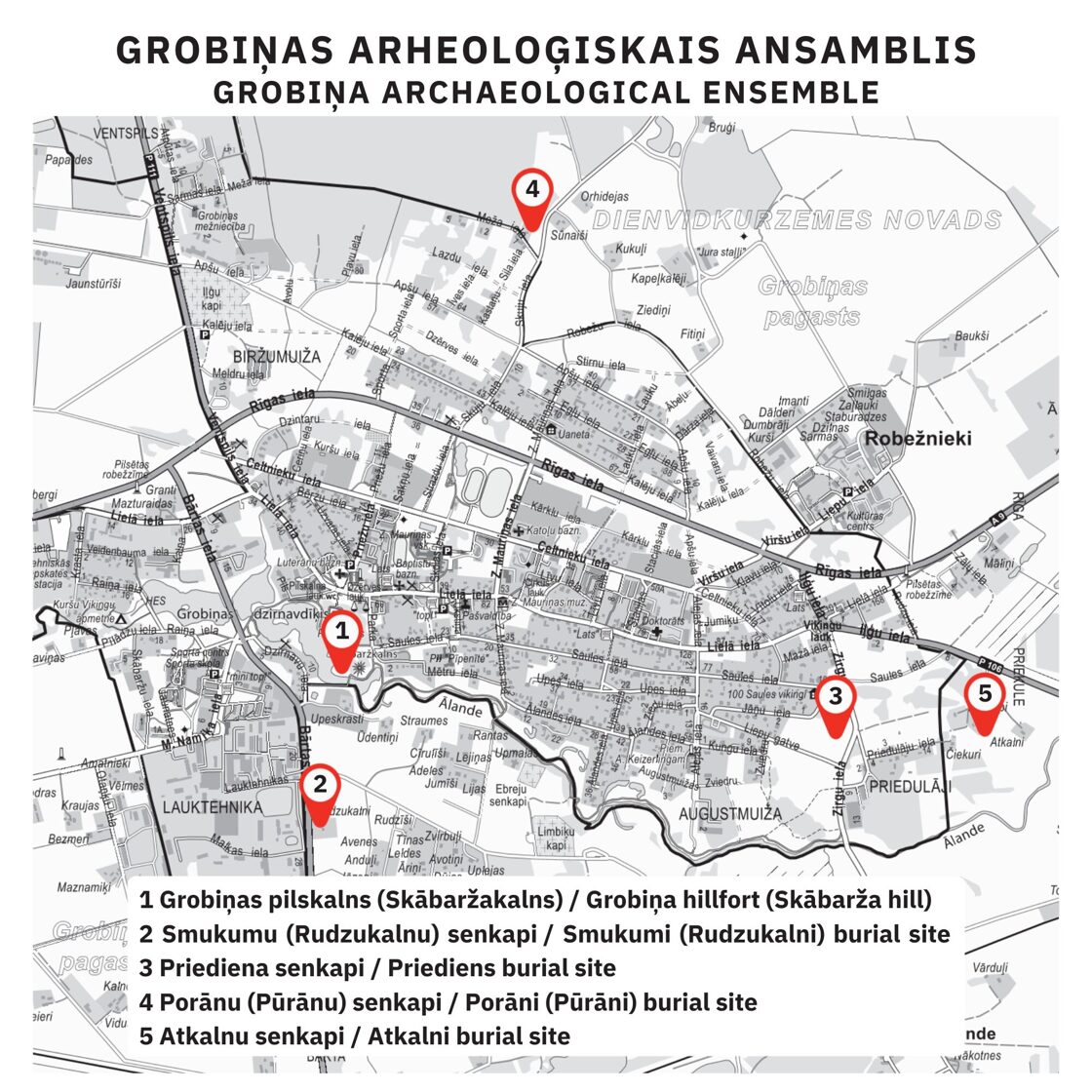Grobiņa Hillfort (Skābaržkalns) and settlement
Grobiņa, Dienvidkurzemes novads
Grobiņa Hillfort, also known as Skābaržkalns, is a site of great historical and archaeological significance. Since the early 1st millennium AD, the area was inhabited by the Curonians, an ancient Baltic tribe. The hillfort rises 5 meters above the level of the Dzirnavu Pond and is covered with trees, including 23 hornbeam trees, which contribute to the name "Skābaržkalns" (Hornbeam Hill). The site contains a cultural layer over 4 meters thick.
It is believed that this was the location of the ancient Curonian "Jūrpils" (Seeburg), mentioned in Rimbert’s 854 description "Vita sancti Anscarii" (The Life of Saint Ansgar). Additionally, the hillfort is associated with the 13th-century burning of Grobiņa Castle, described in the Livonian Rhymed Chronicle. Extensive archaeological research has been conducted on the hillfort Today it is available year-round to visitors offering the opportunity to explore the 2.6 km Ālande River trail and delve into ancient history at the live history festival "SEEBURG."
History
It is believed that the ancient Curonian "Jūrpils" (Seeburg), mentioned in the 854 account "The Life of Saint Ansgar" (Vita sancti Anscari), was located here. In this work, the Archbishop of Hamburg-Bremen, Rimbert (Rimbertus), writes about the conquests of the Swedish King Olaf in Courland and Apole (now part of Lithuania), where, like in Grobiņa, the Baltic Curonian tribe, also known as the Kurši, lived.
The Grobiņa Hillfort is also associated with the burning of Grubîn Castle, described in the 13th-century Livonian Rhymed Chronicle (Livländische Reimchronik). Events in Jūrpils, identified as Grobiņa, mentioned in Rimbert's chronicle of the 9th century, are one of the main motifs in the novel “Kuršu Vikingi” (Curonian Vikings) (1998) by Valdis Rūmnieks and Andrejs Migla.
In literature, Grobiņa Hillfort is recognized as a fortified Curonian settlement. However, the question of the ethnic and cultural identity of its inhabitants during the 7th–9th centuries, when both Curonians and Scandinavians lived in the Grobiņa region, remains unresolved.
Research
The hillfort and its surroundings were mentioned in literature as early as the 19th century, but the first detailed description and survey were conducted by Ernests Brastiņš in 1922. The first archaeological excavations took place in 1929–1930 under the direction of Fr. Balodis and Birger Nerman. The most recent archaeological excavations, led by A. Šnē and E. Guščika, were carried out in the hillfort and ancient town area from 2016 to 2018. These latest studies revealed that the territory of the ancient town and Skābaržkalns had been inhabited since the early 1st millennium, with a cultural layer in the hillfort exceeding 4 meters in thickness.
The name Skābaržkalns (Hornbeam Hill) is derived from the name of the town, Grobiņa. In the Curonian language, gruobs means hornbeam or hornbeam forest.
Novadays
Today, the hillfort is covered with trees, including 23 hornbeam trees. The hill rises 4.5–5 meters above the level of the Dzirnavu Pond, through which the Ālande River flows. Along the river, a 2,6-kilometer-long, well-maintained walking trail winds its way to the Priediena ancient burial ground, the largest known burial site in the Grobiņa area.
A live history festival, "SEEBURG", is held at the hillfort, allowing visitors to explore ancient history.
The lifestyle of the ancient Curonians and Scandinavians can also be experienced at the Active Tourism Center "Curonian Viking Settlement”
Accessibility
The hillfort is open year-round, 24/7.
Parking is available nearby (free of charge).
A staircase leads to the top of the hillfort.
A well-maintained walking trail runs alongside the hillfort and the Ālande River, with a total length of 2.6 kilometers (one way).
The trail is also suitable for walks with strollers, cyclists, and wheelchair users with assistance.
Information stands along the trail provide insights into Grobiņa’s history and landmarks in Latvian and English.
Grobiņa Hillfort and the settlement are part of the Grobiņa Archaeological Ensemble, listed in Latvia’s national inventory for UNESCO World Heritage.
